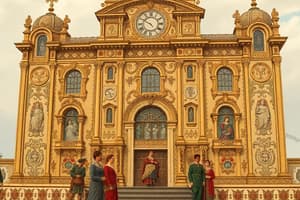Podcast
Questions and Answers
Which of the following factors made Italian unification more difficult?
Which of the following factors made Italian unification more difficult?
- Lack of resources
- Foreign threats (correct)
- Support from Austria
- Different territories trying to lead (correct)
Which leader was significant in German unification?
Which leader was significant in German unification?
- Otto Bismarck (correct)
- Louis-Napoleon
- King Emmanuel II
- Giuseppe Garibaldi
What was the only significant factor that slowed down German unification?
What was the only significant factor that slowed down German unification?
Different nationalities
The three wars of German unification were the _____ war, _____ war, and _____ war.
The three wars of German unification were the _____ war, _____ war, and _____ war.
What were the three most important figures for Italian unification?
What were the three most important figures for Italian unification?
What two main strategies did Bismarck rely on for achieving German unity?
What two main strategies did Bismarck rely on for achieving German unity?
What commonalities did both German and Italian unifications share?
What commonalities did both German and Italian unifications share?
What state had the strongest military power in Germany?
What state had the strongest military power in Germany?
Which country faced challenges in unification due to easier boundary settings?
Which country faced challenges in unification due to easier boundary settings?
What was the significant economic advantage for Prussia during German unification?
What was the significant economic advantage for Prussia during German unification?
What term describes the result of both German and Italian unification?
What term describes the result of both German and Italian unification?
Who is referred to as the 'Brain' of Italian unification?
Who is referred to as the 'Brain' of Italian unification?
What were the consequences of the unification processes in both Germany and Italy?
What were the consequences of the unification processes in both Germany and Italy?
Study Notes
Comparison of Italian and German Unification
-
Italian Unification
- Faced difficulties due to multiple territories vying for control.
- External threats from Austria, Prussia, and France complicated efforts.
- Key leaders included King Emmanuel II, Giuseppe Garibaldi, and Louis-Napoleon.
- Aimed to remove foreign influence, especially from Austria, using alliances with France and Britain.
- Led to significant revolutions throughout Italy.
- Main figures: Mazzini, Garibaldi, and Cavour, the "Brain" who combined diplomacy and military actions for unification.
- Lack of a cohesive economic strategy, limited to regions like Piedmont where Cavour implemented reforms.
-
German Unification
- Less contentious among states; reconvened post-initial failure by adopting new ideals.
- Key figure: Otto von Bismarck, known for his "Blood and Iron" approach emphasizing military strength and industrialization.
- Unification primarily fostered through three wars: Danish War, Austrian War, and Franco-Prussian War.
- Strong military power came from Prussia, the leading German state.
- Bismarck’s Realpolitik focused on strengthening military and industrial power, disregarding political ethics.
- The establishment of the Zollverein (customs union) significantly boosted the economy.
Commonalities between Italian and German Unification
- Both processes driven by common culture and language, derived from the legacy of the Roman Empire.
- Each faced various states under foreign rule, creating a backdrop for unification.
- Presence of secret societies that mobilized support for unification efforts.
- Success in wars against foreign powers played a crucial role in strengthening national identity.
- Leading nations promoting unification were Sardinia for Italy and Prussia for Germany.
- Both regions faced the complexities of geography; Italy had natural boundaries while Germany struggled with endless plains.
Geography and Economy
-
Italy
- Geographical advantages included mountains and seas facilitating boundary setting.
-
Germany
- Challenged by vast plains without natural borders, complicating unification efforts.
- Economic advancements linked to the success of the Zollverein, elevating Prussia’s status.
- Contrasting Italy, which lacked such a unified economic framework outside of reforms in Piedmont.
Impact of Unification
- Nationalism surged in both countries as a significant outcome of the unification processes.
- Both unifications resulted in long-lasting changes, driving independence, economic growth, and strong national identities.
- The journeys toward unification were marked by conflict and intricate political maneuvers, with Italy facing more fragmentation.
Leadership Dynamics
- Bismarck's military-centric leadership contrasted with Cavour’s more diplomatic approach.
- Both leaders had vastly different strategies; Bismarck relied on force while Cavour sought political approval and alliances.
- Italy’s path was more arduous due to numerous fragmented territories needing integration into a singular state.
Resulting Nationalism
- Ultimately, both unifications produced a surge in nationalism within their respective nations, influencing future political landscapes and identities.
Studying That Suits You
Use AI to generate personalized quizzes and flashcards to suit your learning preferences.
Description
Explore the key differences between the unification of Italy and Germany through these flashcards. Understand the challenges faced by Italy in unifying multiple territories and the more straightforward process experienced by Germany, especially in the context of military strength. Test your knowledge and grasp the historical significance of these two events.




